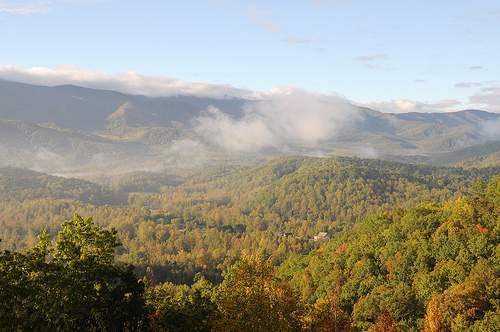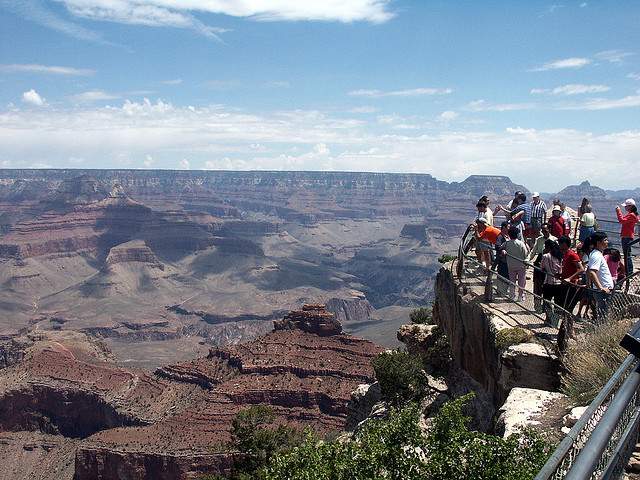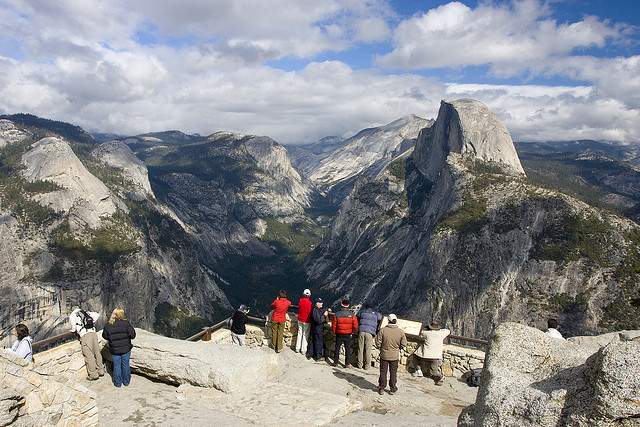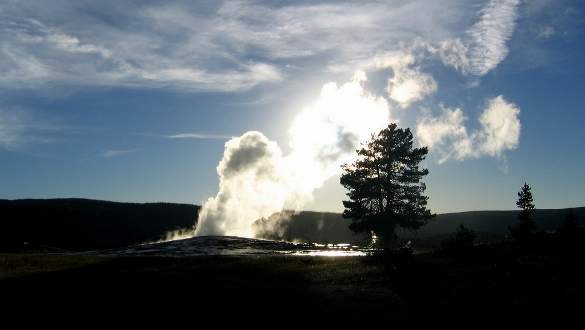We’ve all been there. After doing a world of research and planning the perfect trip, you arrive at your destination to discover it completely overrun with tourists. In the case of our national parks, your peaceful commune with nature turns into a stressful battle against traffic and screaming kids. But if you’re willing to spend a little more time and effort than the average tourist you can have a better trip. Here are my suggestions how:
Great Smoky Mountains
A number of major highways run through and around this park, making it easy for visitors to cruise through, snapping photos of wildlife and the stunning views. Your shots of mountains and deer, however, might seem a little less special with throngs of cars and people in the background.
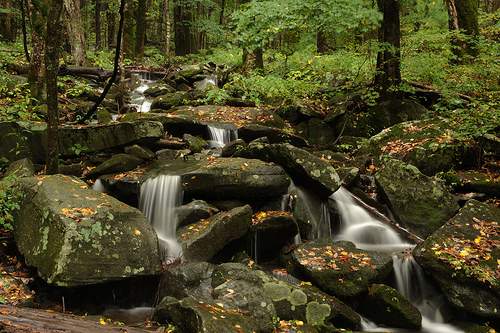 The solution: Get out of your car! Don’t be a “windshield visitor.” From waterfalls to old railway beds, ruins of cars, cabins and more, there’s so much to explore in the park that can’t be seen from your car. Best of all, when you do pause to take that photo of the smoke on the mountains, you’ll have the peace and quiet of them all to yourself.
The solution: Get out of your car! Don’t be a “windshield visitor.” From waterfalls to old railway beds, ruins of cars, cabins and more, there’s so much to explore in the park that can’t be seen from your car. Best of all, when you do pause to take that photo of the smoke on the mountains, you’ll have the peace and quiet of them all to yourself.
Your choice of hikes can range from a quick mile stroll to an all day excursion. For a quick but pretty walk, park at the Indian Creek Falls trailhead. Less than half a mile down Deep Creek Trail, you’ll reach Tom’s Branch Falls, 80 feet tall and with a nice spot to rest and enjoy the falls. If you wish, you can continue the on to Indian Creek Falls, making your total round trip hike just under 2 miles. For a moderately difficult hike, try the 4 mile (round trip) Porters Creek Trail, down a short gravel road just inside the park. During the length of this trail, you’ll pass an old homestead, two waterfalls, and depending on the time of year, gorgeous patches of wildflowers.
The more ambitious among us can hike to the summit of Mt. Cammerer to some of the most amazing views in the park. Follow the signs for the Low Gap Trailhead, which begins in Cosby Campground. After about 2 miles, the trail meets up with the Appalachian Trail, which in turn leads to the Mt. Cammerer Trail. At 12 miles round trip, this is a strenuous hike with serious elevation gain, but culminates in a panoramic view of the park that you won’t forget.
>> Book flights to Tennessee or find a hotel in Gatlinburg
The Grand Canyon
It almost feels like required protocol when you go to the Grand Canyon: follow the rest of the cars to the South Rim, circle endlessly for a parking spot, edge your way through to the rail, and get the “me at the rim of the Grand Canyon” snapshot. Problem is, it’s almost impossible to capture the grandeur of the canyon from the edge. And you feel like so many lemmings on the cliff, just waiting for your turn on the edge.
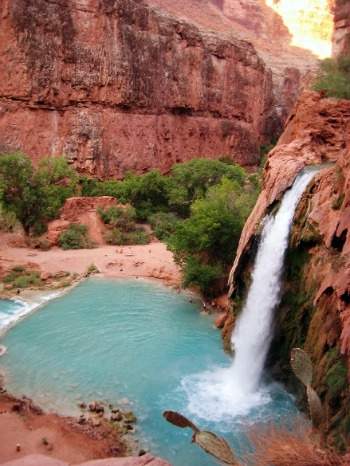 The solution: You could take a mule to the bottom of the canyon, or check out the controversial “skybridge” on the Hualapai Indian reservation. But for the ultimate canyon experience, take a few days to visit the Havasupai falls.
The solution: You could take a mule to the bottom of the canyon, or check out the controversial “skybridge” on the Hualapai Indian reservation. But for the ultimate canyon experience, take a few days to visit the Havasupai falls.
Though not technically in the park, this offshoot of the Grand Canyon is one of the most remote cities in America. You can choose to do the grueling 10 mile hike in (cost: sweat and energy) or fly in via a 5 minute helicopter ride ($85/per person). Lodging choices include the pristine, though primitive, campsite ($17/per person/per night) or the Havasupai inn ($145/per night). Make reservations by calling (928) 448-2121. Either way, be prepared for some of the most stunning desert canyon and waterfall landscapes that you’ve ever seen in your life.
Even when this hidden gem is crowded with visitors, you can always find a corner of the canyon to yourself, as the Havasupai nation caps the number of visitors in the canyon at any time. To ensure a spot, make reservations for the inn or campsite well in advance. Unlike that well known “edge of the canyon” portrait, your friends will have no idea where you found the 200 foot turquoise waterfall surrounded by red desert rock.
>> Learn about hiking in the Grand Canyon and find out how to visit the Grand Canyon from Las Vegas
Yosemite
I asked my husband what he thought of his visit to Yosemite and his answer was frank: “It sucked. Everyone and their brother goes there.” Yikes! It’s no secret that this park is extremely popular with hikers, climbers, and skiers, who take ample advantage of the park’s many trails and rock features. So how do you avoid the crowds?
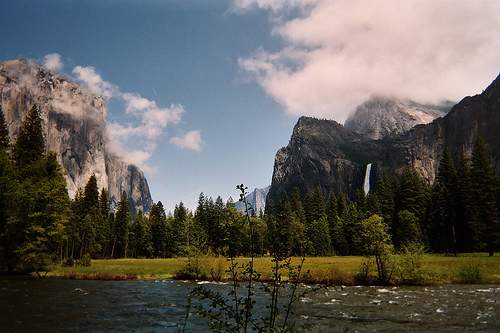 The solution: Try to time your visit to Yosemite in the spring or fall, when there are half as many visitors as during the peak summer season. Avoid the park in August at all costs. In March, the dogwood trees begin to bloom, and the park waterfalls flow beautifully due to the melting snow. If allergies are an issue, consider a visit in the October. The park’s water features won’t be as showy then, but you may catch some of the deciduous trees changing color. Be aware that because of possible snowfall and icy conditions during these seasons, you may be required to carry tire chains in your car. Check the NPS website or call (209) 372-0200 for current conditions.
The solution: Try to time your visit to Yosemite in the spring or fall, when there are half as many visitors as during the peak summer season. Avoid the park in August at all costs. In March, the dogwood trees begin to bloom, and the park waterfalls flow beautifully due to the melting snow. If allergies are an issue, consider a visit in the October. The park’s water features won’t be as showy then, but you may catch some of the deciduous trees changing color. Be aware that because of possible snowfall and icy conditions during these seasons, you may be required to carry tire chains in your car. Check the NPS website or call (209) 372-0200 for current conditions.
Since the park is crowded even during “low season,” visit Yosemite Valley, the park’s most popular area, during the early morning. After all, although everyone wants to see El Capitan, you probably don’t want to see everyone. For a spectacular view of the valley, hike to Taft Point, a 2 mile round trip, moderately difficult hike, which takes you to the top of Sentinel Dome. Spend the busy afternoons exploring lesser-known areas of the park, such as Tuolomne Meadows, where you can enjoy the park at your leisure.
>> Book accommodation in Yosemite
Yellowstone
From the moment you enter this grandest of national parks, the crowds can be unsettling. Around each bend, pile ups of stopped cars become even more commonplace than the buffalo that graze and ignore the crowds photographing them. The boardwalks around the thermal attractions are so crowded that shuttling through them feels like going on rides at Disney.
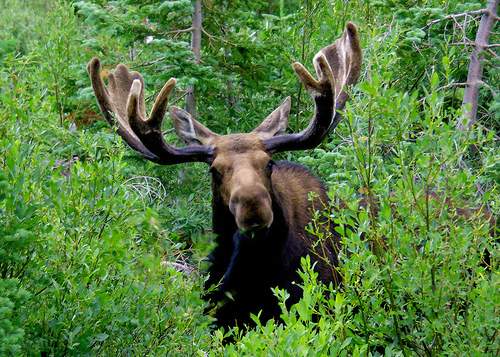 The solution: Stay overnight in the park. You can get in your car and explore the park after dark without a second thought, and might catch a glimpse of some of the more elusive park wildlife, such as wolves, bears, or even mountain lions. Save the park’s most popular attractions (Mammoth Springs, West Thumb ) for the mornings or evenings, when most people are either driving to or leaving the park. Spend the crowded afternoons enjoying some of the park’s alternative activities such as fishing or rowing on the lake.
The solution: Stay overnight in the park. You can get in your car and explore the park after dark without a second thought, and might catch a glimpse of some of the more elusive park wildlife, such as wolves, bears, or even mountain lions. Save the park’s most popular attractions (Mammoth Springs, West Thumb ) for the mornings or evenings, when most people are either driving to or leaving the park. Spend the crowded afternoons enjoying some of the park’s alternative activities such as fishing or rowing on the lake.
Though the park’s thermal attractions are the best known (and most visited) features of the park, Yellowstone is also a great place to hike, bike, and view wildlife. Most visitors drive past Hayden Valley without stopping. Take a moment to stop, as this vast meadow is one of the most popular areas
for wildlife in the park.
Xanterra Parks & Resorts operates a number of lodges at the park, so you can choose one near your favorite area. Rooms in the park’s historic and luxurious inns start at $130/night, while the simpler, more rustic cabins can be had for $70/night. For the more budget minded, campsites in the park range from $12-20 per night. Whether you choose a plush bed with a gourmet restaurant meal or a simple tent and your own campfire, hearing the roar of the park’s thermal features from your room at night is a unique and thrilling experience.
>> Find flights to Yellowstone
Rocky Mountain National Park
The biggest downside of this beautiful park is that there is one road that runs through it, and that road is a highway. State highway 34 runs across the park from Grand Lake to Fall River, going up into the mountains in the middle. To add to the pain, on 34 just outside the park is Estes Park, a popular resort and ski destination. This means that vast areas of the park are completely unreachable by paved roads, while traversing the park means crawling painfully behind cumbersome RVs that can’t negotiate the steep switchbacks going up or down.
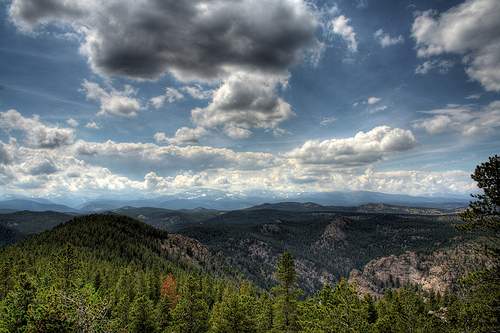 The solution: Grab a backpack and head into the backcountry. Rocky Mountain has dozens of backcountry camping sites, most with privys. Some are located as little as one mile from the trailhead, so you won’t have to lug your gear far. For the more adventurous, other sites get you far from the crowds and up into the mountains most people are happy to just look at. Park rangers are the best sources of information and can help you choose a campsite that best suits your needs. There is even a wheelchair accessible site at Sprague Lake.
The solution: Grab a backpack and head into the backcountry. Rocky Mountain has dozens of backcountry camping sites, most with privys. Some are located as little as one mile from the trailhead, so you won’t have to lug your gear far. For the more adventurous, other sites get you far from the crowds and up into the mountains most people are happy to just look at. Park rangers are the best sources of information and can help you choose a campsite that best suits your needs. There is even a wheelchair accessible site at Sprague Lake.
Whichever site you choose, be sure to get a backcountry permit ($20) and to follow the basic tenants of backcountry camping: keep a clean campsite, camp only in designated areas, and prepare for extreme weather and emergencies. Rocky Mountain is bear country, so keep garbage and other food items well sealed and scented items such as deoderant in your car. It’s sure to be an amazing experience – the last time I camped at Rocky Mountain, we came back to our site in the evening to discover that several herds of elk had wandered into a meadow by our site. They munched on grass peacefully and regarded us without fear when we tiptoed over to take photos.
If you prefer not to camp, one pleasant alternate when driving through the park is to take Old Fall River Road off highway 34. Although the posted speed limit is 15 miles per hour along this gravel road, it is much less frequented than the main road, which makes driving it a more leisurely and relaxing experience. Be aware that there are steep drop offs and no rails, so drivers must be careful and aware, and road only runs one way, from Grand Lake to Fall River. And for the love of your poor brake pads, please learn how to engine brake before taking your vehicle back down the mountains. Right before the road rejoins 34 at the Alpine Visitor Center, there is a spectacular steep hike up a pleasant grassy incline which leads to spectacular views. This is a fantastic spot to enjoy the alpine scenery and often see marmots and other wildlife before heading back to the crowds.
>> Find flights to Denver and book a Denver hotel
Read more about National Parks:
- Five Best US Cities for National Parks Lovers
- Best National Parks iPhone Apps
- Six National Parks You’ve Probably Never Visited
- The First Timer’s Guide to Planning a National Park Vacation
Photos by: carlwwycoff, atonal, tfdavis, glenwilliamspdx, adrian valnezuala, Al_HikesAZ, wallyg, Scott Ingram Photography
